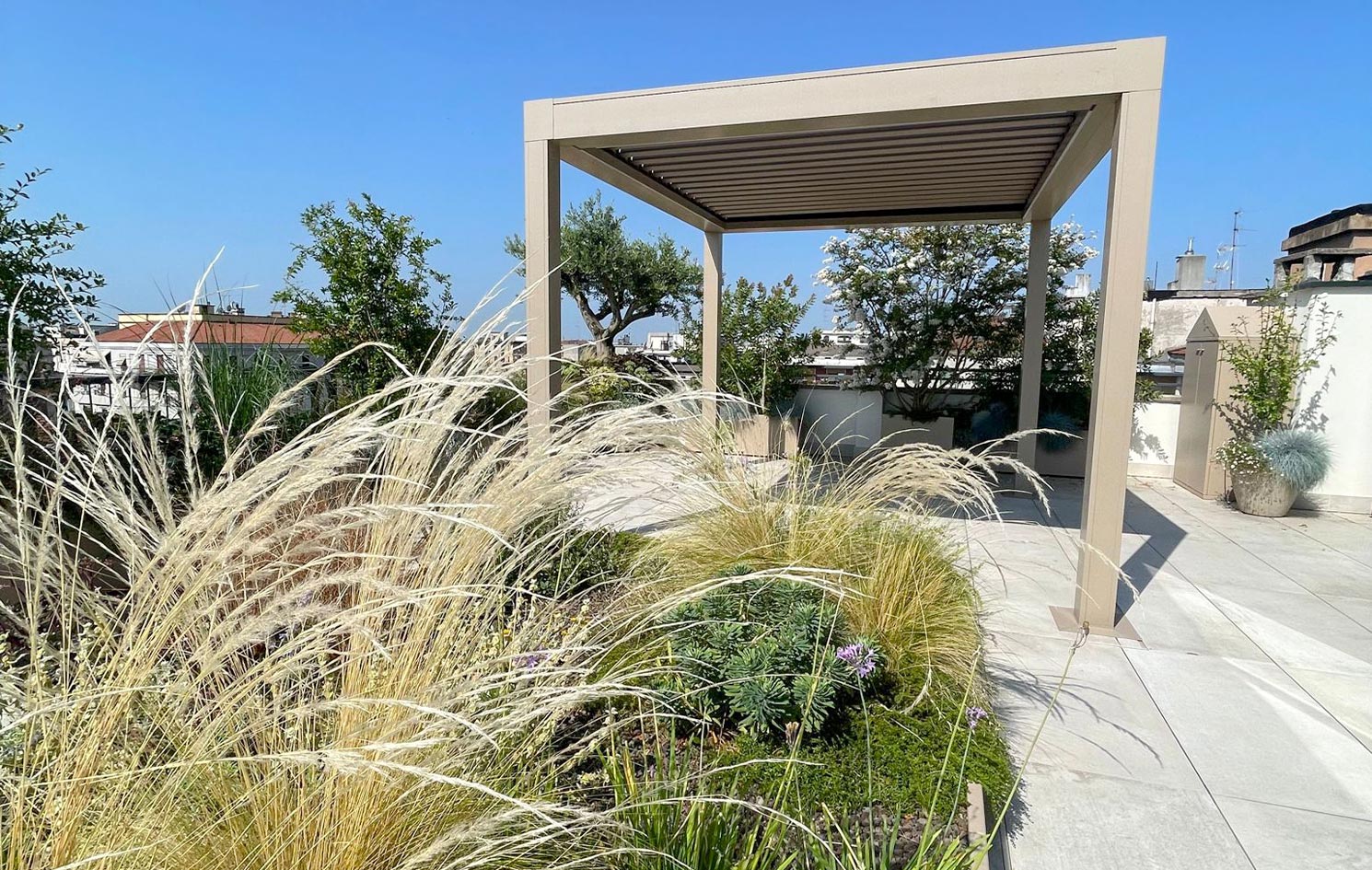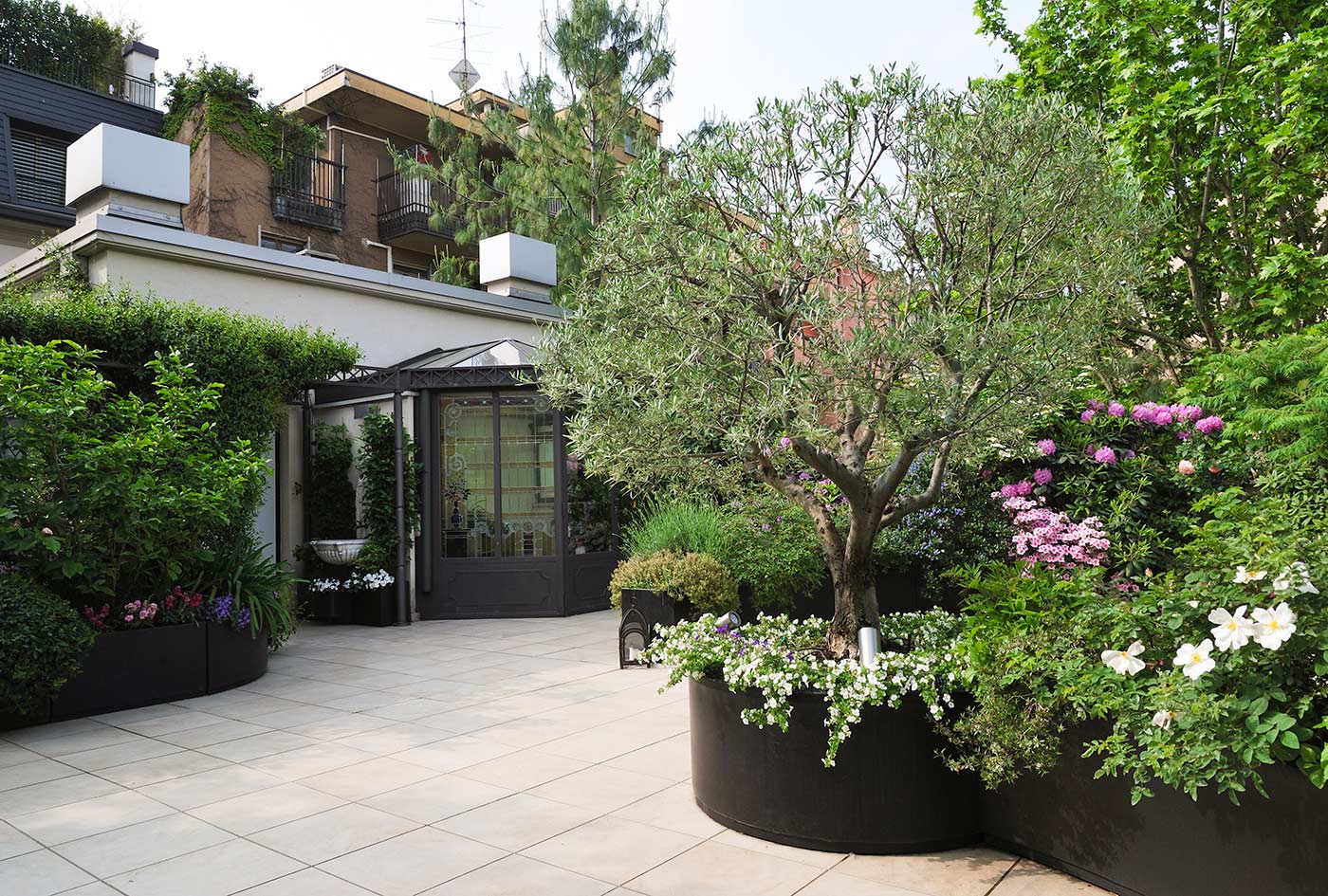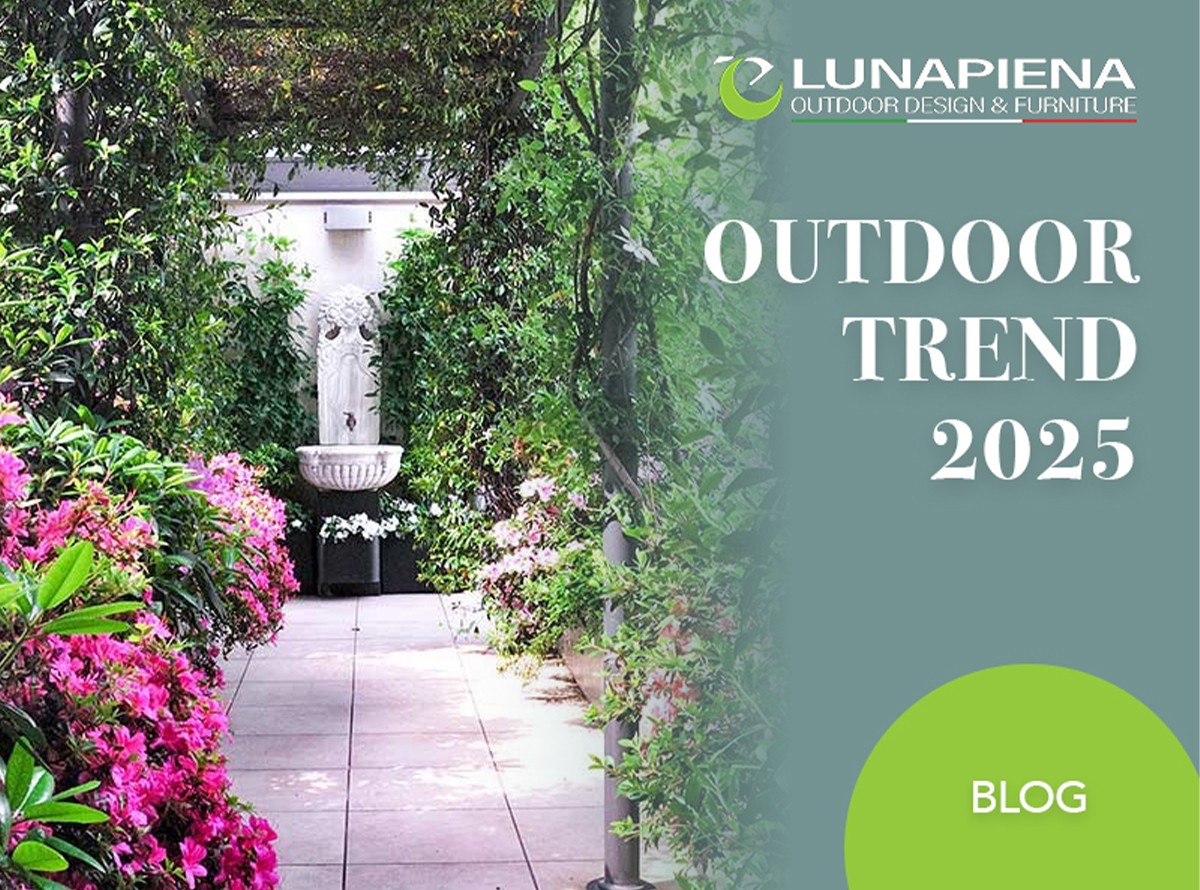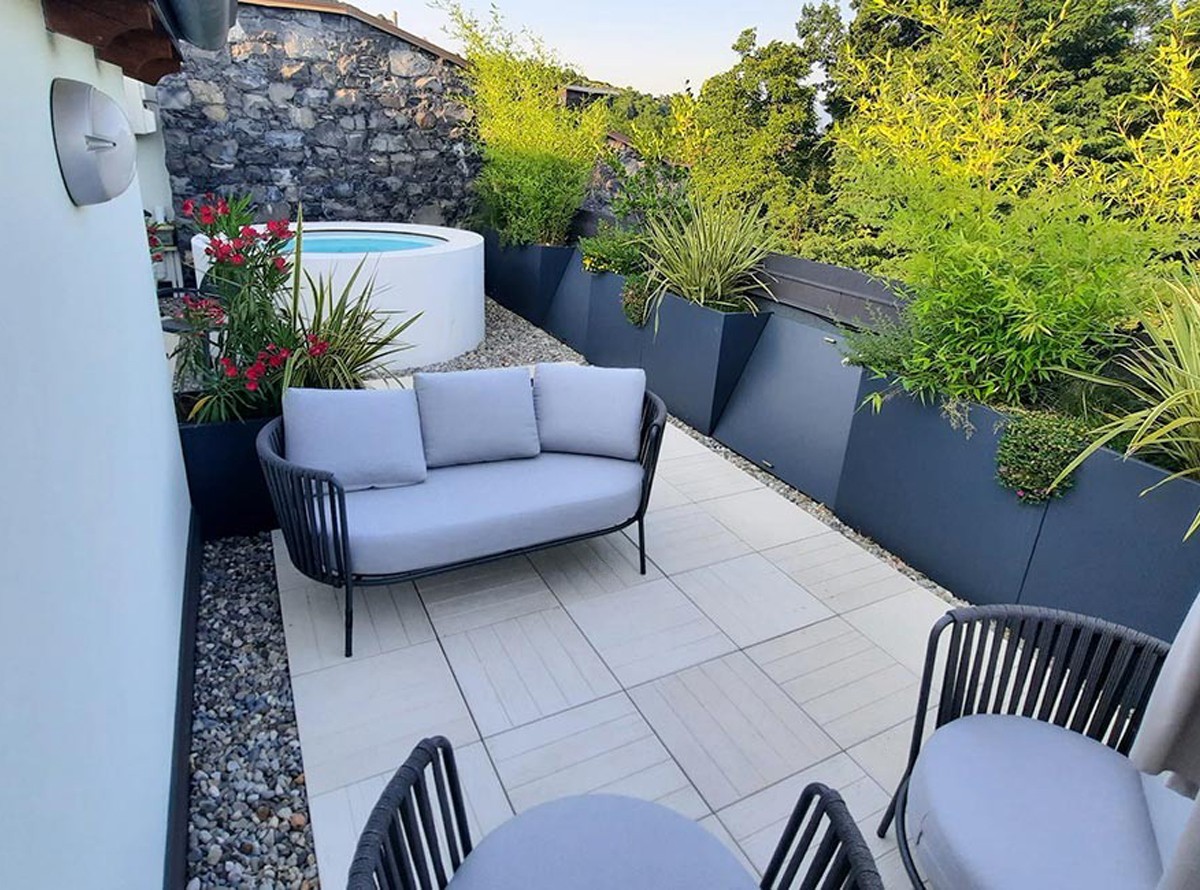Thanks to bioclimatic pergolas and bioclimatic greenhouses, you can now live and enjoy your outdoor spaces even in winter. In fact, these structures allow you to create a new livable space. At the same time they allow you to reduce your energy consumption. Find out how by reading the article!
Outdoor spaces are becoming increasingly important in modern living, especially after the lockdown periods caused by COVID-19.
Living with nature. This is the new priority for people who increasingly desire a dedicated space to disconnect from daily stress and rejuvenate. This need gives rise to other requirements, such as a cozy sitting area to relax, choosing the right plants to create a welcoming and aesthetic area, or a shaded spot to enjoy pleasant days. Creating a comfortable space that combines relaxation and nature is possible — with the right style, you can make the most of your garden, terrace, or balcony.
There are countless solutions on the market, and finding the right one can be challenging. With over 20 years of experience, we can help clear your doubts and guide you toward the best solution.
In this article, we will explore two of the best outdoor solutions on the market: bioclimatic pergolas and bioclimatic greenhouses. These innovative alternatives not only enhance the livability of your home but also contribute to reducing energy consumption. However, it’s important not to confuse the two! Pergolas and greenhouses differ structurally and legally.
Why? èLUNAPIENA is here to help you! Let's find out together
BIOCLIMATIC PERGOLA
What is a bioclimatic pergola?
A bioclimatic pergola is a structure with adjustable aluminum slats that creates an intermediate space between indoors and outdoors. This product combines aesthetics and functionality, allowing you to enjoy the outdoors 365 days a year.Choosing closed bioclimatic pergolas can be an ideal solution to add a personalized relaxation area to your home or expand your commercial space during milder months. With the right furniture, you can create stunning and engaging lounges, sitting areas, or shops—all year round.
How are bioclimatic pergolas built?
Bioclimatic pergolas can be open or closed, attached to the main building, or freestanding in an open space. With thoughtful architectural planning, they are easy to install and can be customized in size. Thanks to our production team, èLUNAPIENA can even provide custom-made bioclimatic pergolas, tailored to your needs.How do bioclimatic pergolas work?
The primary feature of bioclimatic pergolas is their adjustable aluminum slats, which form the roof. These can be manually or automatically adjusted to create the perfect microclimate while protecting guests from sun, rain, snow, and wind. Side enclosures, often glass, can be added to enhance protection from cold and weather. Combined with climate control systems, these features allow you to enjoy outdoor spaces year-round.Bioclimatic pergolas: Cost
Wondering how much a bioclimatic pergola costs? Focus not just on the price but consider it an investment in well-being. A bioclimatic pergola lets you enjoy outdoor spaces without high energy consumption, as the slatted system allows you to control the amount of sunlight and shade.
Terrace Beatrice Project: a pergola to live the outdoor. Click here and discover more!
BIOCLIMATIC GREENHOUSE
What is a bioclimatic greenhouse?
A bioclimatic greenhouse is a sustainable building solution that creates a usable, semi-habitable technical space. Like pergolas, greenhouses can be furnished as desired, provided they don’t become fully livable rooms used constantly. This distinction between greenhouses and bioclimatic pergolas lies in their intended habitability.How are bioclimatic greenhouses built?
A bioclimatic greenhouse can be integrated into or placed adjacent to a building, usually facing south to maximize heat absorption.How do bioclimatic greenhouses work?
These greenhouses are designed to maximize sunlight entering the structure, warming the space in winter and promoting heat dissipation during summer.Bioclimatic greenhouse: Regulations
Building a bioclimatic greenhouse requires adhering to specific laws. They must integrate seamlessly into the surrounding architectural context and not count toward the property’s volume. National, regional, and local regulations must be followed, including requirements such as: “At least 50% of the dispersing surface must consist of transparent elements with U ≤ 1.5 W/m²K.”, so a greenhouses must use thermal profiles — known as warm profiles — to avoid thermal bridgingBioclimatic greenhouse: Cost
When considering the cost of a bioclimatic greenhouse, remember it’s a significant investment that also impacts energy consumption. A greenhouse reduces energy use by storing heat that can be transferred to the main building. A greenhouse on a terrace. Click here and discover the èLUNAPIENA project.
A greenhouse on a terrace. Click here and discover the èLUNAPIENA project.Key Differences Between Bioclimatic Pergolas and Greenhouses
Although similar, these two outdoor living solutions differ significantly, particularly in terms of thermal insulation:- Aluminum profiles. Greenhouses use warm profiles that provide sufficient insulation, while pergolas use cold profiles requiring additional heating and cooling systems for comfort.
- Glass. Greenhouses feature double or triple-glazed glass for strong thermal insulation, whereas pergolas typically have single-glazed glass.
Greenhouses act as "large radiators", reducing the energy required to heat your home or commercial space; while pergolas serve as "advanced sunshades", protecting walls and windows from sunlight and improving outdoor thermal comfort.
Regulations for Greenhouses and Pergolas
Greenhouses are considered freestanding, climate-controlled constructions that increase a property’s volume and must comply with specific regulations. Pergolas, on the other hand, if made with lightweight, movable materials and ensuring a perforation ratio of at least 4/5, can be installed without permits.Pergola vs. Greenhouse: Which to Choose?
But so is it better to prefer a bioclimatic greenhouse or a bioclimatic pergola? The choice depends on your intended use. If you need additional space, a bioclimatic greenhouse is the ideal solution. For outdoor comfort, a bioclimatic pergola is an excellent choice.What About Verandas?
It’s important to clarify that a bioclimatic greenhouse is not the same as a veranda! A veranda, with its supporting structure and climate control system, is subject to specific building regulations. Greenhouses, considered sustainable building elements, are tax-free and do not require construction permits.Need Help Choosing? èLUNAPIENA Is Here for You!
In this article, we’ve explained what bioclimatic greenhouses and pergolas are, how they work, and the key differences. Both are excellent products for redefining outdoor spaces—the choice depends on how you plan to use them to enjoy your space year-round.If you’re still unsure, èLUNAPIENA and its team are ready to help with personalized consultations and custom project creation.
With extensive experience and high-quality catalog products, we guarantee a functional, practical, and aesthetic result through custom installations tailored to your needs.
Whether you’re a homeowner looking to add an “extra room” or part of the HORECA industry seeking to create an outdoor space for guests to enjoy stunning views and unique experiences year-round, we’ve got you covered.
Contacts us and discover our products!
But act quickly! The Green Bonus can save you up to €5,000 on your purchase. Click here to learn more!Chiudi dettaglio







